Bali
(II) . . .
03 March '98
| We're headed off on a three-day tour of Bali with Ningah. After breakfast
we packed up and stashed most of our luggage in the office of Kokokan to await our return.
Ningah has never been to some of the places that we want to visit and seems excited to be
going. We headed right across the middle of Bali, traversing its widest portion south to
north. We stopped at the town of Bedugul on Lake Bratan (an old caldera) to go birding . .
. lots of little twittery things high in the canopy but we couldn't I.D. anything new.
Stopped for lunch at a Balinese restaurant in Gitgit, then on to Singaraja ('Lion King' in
Balinese) where we turned west along the north coast road.
Stopped at a roadside stand to buy some
fruit. Our favorite is 'rambutan' (means 'hair fruit'). As ever, you pick the fruit you
want, ask how much it costs, offer 50%, and settle for 75%. We always paid too much by
Balinese standards, but everything is so ridiculously cheap that we don't mind. |
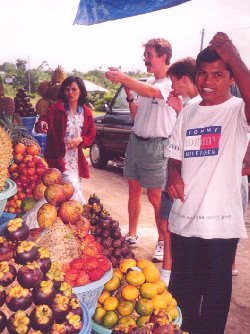 |
| We checked out several accommodation
possibilities in Lovina but found the atmosphere of whole region wanting . . . tired and
dirty. So we continued on west until we came to the town of Pemeturan, where we found a
charming place called Taman Sari. To reach our cottage we crossed a koi pond on a little
wooden bridge. The entire bathroom suite was out of doors, surrounded by high stone walls;
Ty's bed was built on stilts at the edge of the pond. |
While getting ready for bed K.
noticed this beautiful Tokay Gecko crawling along a rafter overhead. 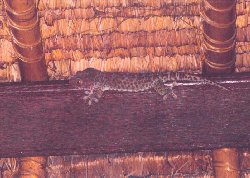
|
04 March '98
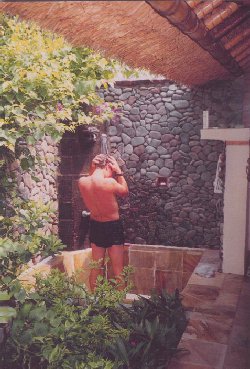 |
Ningah picked us up at Taman Sari
at 0600. He'd spent the night with relatives in West Bali. He spent several years of his
youth working on this family's copra plantation but had not seen them for the past three
years, until yesterday. Apparently many relatives showed up to welcome him back and
everybody stayed up most of the night. He is pretty tired today.
We drove one hour west to a village
called Lauhan Lalang. There we found a fellow named Pottu (another one) . . . and we
negotiated for his services for a day as our guide bird-trekking in Bali Barat National
Park, plus he would arrange for boat transport and guide us on a diving trip out to
Menjangan Island (off Bali's NW tip). |
We all piled into Ningah's car and
drove to Bali Barat for trekking and birding. Ty spotted several new ones, including a
Black Drango, Green Pigeon, Horeo, Sunbirds and Rustbirds. Deep in the forest we came to
the Bali Starling Release Center. The Bali Starling is one of the rarest birds in the
world . . . only 35 birds still exist in the wild, plus a dozen breeding pairs in
captivity. The release center is their last and only hope for survival.
We were all fairly soaked in sweat
by the time we came out of the forest. Drove back to Labuhan and picked up boxed lunches
of Balinese food, climbed into a long blue and white boat for half-hour run out to
Menjangan Island for skindiving.
It was the finest diving we've seen
since Palau . . . at least two hundred feet of underwater visibility and an incredible
variety of fishes. Dan dove down and stroked the back of a meter-long cuttlefish. It
seemed to enjoy the petting and pulsed through an impressive array of color and pattern
changes. Ty dove down to a huge shoal of thousands of foot-long blue and silvery fusiliers
that all turned and shimmered as one as he swam through them. |
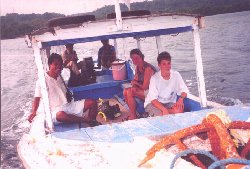 |
05 March '98
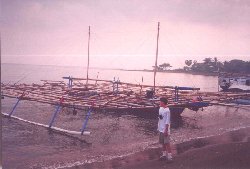 |
Dan and Ty woke at dawn to walk the
beach and look for birds. Rows and rows of outriggers on the beach . . . small boys
throwing out handlines for squid. These little ones were up early to welcome their dads home with the
night's catch. |
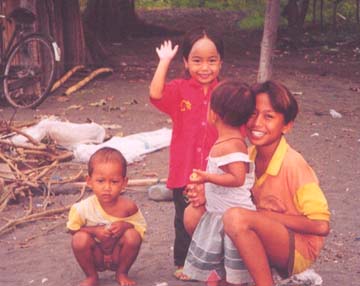 |
Ningah spent another night with his relatives in
Cekik, and picked us up from Taman Sari at 0930. East across the top of Bali along north
coastal road. Past Singaraja we turned south on a bumpy and narrow road heading back into
the hills.
We were looking for the small village of Sawan,
where the finest Gamelan musical instruments reputedly are made. After a couple false
turns and asking along the way we located the village, and finally found the little
foundry where gongs are cast.
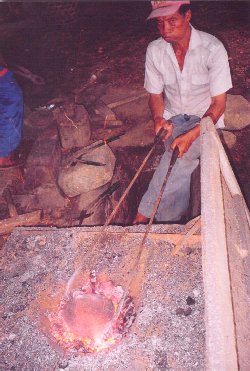 |
For generations members of the same
few families have worked in this shop, all living in houses surrounding the foundry and
workshop area. The clan leader spoke little English, but nonetheless proudly led us
through each stage of the gong-making process. It's a very labor intensive business,
requiring several people five or six days to produce one perfectly tuned Gamelan gong.
First molten bronze is poured into a
lens-shaped mold carved into a rock. After it cools this ingot is carefully reheated and
for the next several days is hammered over an anvil with a hard wooden mallet (one boy
pumps the skin bellows, one man turns the hot metal, one swings the hammer).
When everybody decides they like the
shape a woman takes it and polishes the center strike-point, and finally it is given to a
very ancient guy who exactly tunes it by filing away metal at the edge. |
| Ningah is an accomplished Gamelan musician and gave
Ty a lesson. Unlike all other
vendors we'd encountered in Bali, these people weren't much inclined to negotiate price.
After listening to many different gongs we chose one and gladly paid what they asked. They
will ship it home for us. |
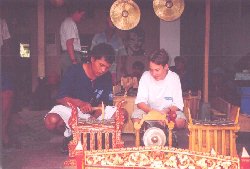 |
Found our way back to the main road and
headed for the eastern end of Bali. We turned onto a very rotten and pot-holed road near
the town of Amed and after 10 k's found a pleasant beachfront bungalow at Hidden Paradise
Cottages (who names these places?).
06 March '98
After dinner last night we went for a
walk and met a fellow on the beach who said for $4 he would arrange for us to go fishing
with his 'brother' the next morning. So one hour before dawn we met Nioman when he pulled
his outrigger canoe up onto the sand. Not much gear on board. Safety equipment consisted
of a few pints of water in a plastic bottle. None of us were impressed with the size of
this hollowed-out log that was to carry us offshore into an inky black sea, but after we
got under way we were amazed at how stable the boat was. Nioman climbed over us up to the
bow and raised the lateen sail.
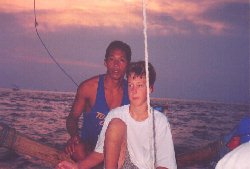 |
As the dawn gently pinked over the
Bali Sea we started to make out a few other boats heading off shore, and finally we
realized we were surrounded by hundreds of similar craft all daring the open ocean to hunt
schools of mackerel. It was a wonderful view of the melon pink dawn breaking over a glassy
sea, peppered with hundreds little bug-shaped boats. |
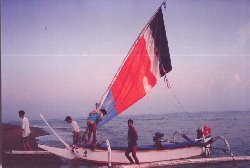 |
After we were several miles offshore
the land breeze died away so our skipper started the engine, and we started fishing.
Something about the engine seemed familiar, and then Dan realized it consisted of the
exact same motor as we have on our lawnmower at home, to which a shaft had been bolted
with a bare spinning prop affixed to the end. Like everything on this little boat, it was
elegantly simple and worked like a charm.
The mackerel schools eluded us this
morning and all the boats started heading back to the beach by 0730. We grabbed a quick
breakfast, and 20 minutes later climbed into another little outrigger that carried us a
mile or so west to a prime snorkeling spot. The coral was not as spectacular as at
Menjangen Island, but again the tepid gin-clear water was teeming with fish, including
wrasses, trumpetfish and boxfish that we'd never seen before.
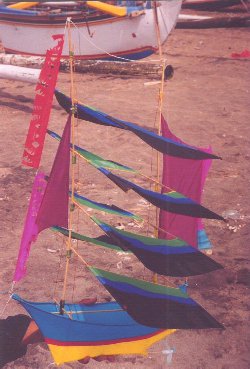 |
When we returned Ty came across an old man on the
beach making beautiful kites configured like square-rigged sailing ships. There was no
wind so we don't know if they actually fly. Even so, they were so pretty that we bought a
couple. |
At 1000 Ningah showed up with friend
Gusti (night manager at Kokokan) to pick us up. We drove south through a pass between the
two great volcanoes of Agung and Seraya. The most recent serious eruption in Bali was of
Agung in 1963 and many villages and thousands of lives were lost.
We stopped and swam in the Royal Pools in
Tirthagangga. Built by the last great king, Raja of Karangasem, they were part of an
extensive series of pools and moats called the Great Water Palace. Mostly destroyed in the
eruption of Mt. Agung in '63, parts have been rebuilt and are open to the public for a
small fee (ten cents).
|
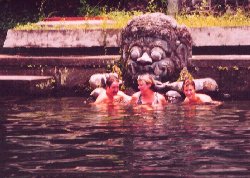 |
From the resort town of Candi Dasa we
again turned north into the mountains until we came to the town of Tenganan, the center of
ikat weaving. While K. shopped for this rare fabric, D. and T. went exploring with Gusti.
We were the only white faces in the village and received a lot of attention.
The boys were told that a cockfight was
soon to be held so they explored until they found the dirt arena behind some derelict old
buildings. In order to see better over the quickly gathering crowd D. and T. climbed a
crumbling wall for a good view. Cockfighting is the premier spectator sport and is legal
in Bali . . . gambling is not. But gambling is what cockfighting is all about, so it's all
done on the sly.
Many of the fighting birds are in
evidence, carried about in woven cages, but only a few will fight today. The rest are on
hand in order to familiarize them with all the brouhaha, so that when their day of
reckoning comes they'll not be distracted and will tend only to the task at hand . . .
which is to hate and kill their opponent.
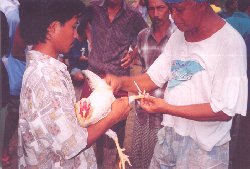 |
The whole affair is
steeped in tradition. First of all, the picking of the fighting pairs, then the careful
selection of knives and tying them onto the birds' feet . . . always yellow thread for one
bird, red for the other. Next this scrawny old bald guy makes an offering to whatever gods
are paying attention. |
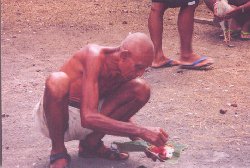 |
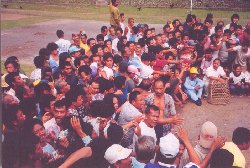 |
The birds are
paraded around the pit in front of the crowd, and then the serious betting begins. It was
very confusing to us, but obviously several rounds of betting take place, with much
shouting back and forth by everyone, and the odds changing with each round.
It is strictly forbidden for women to
attend cockfights, but when Kaaren slipped into the crowd, though she stood out like a
bright light in all the brown faces, she was politely ignored. |
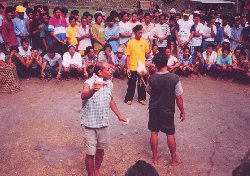 |
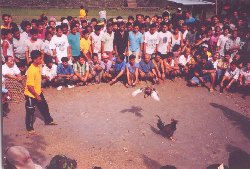 |
Finally the owners, squatting
several meters apart, release their birds. The birds first just stare at each other with
heads down and nape hackles all ruffled up. Then suddenly they fly at each other like
crazed samurai, leaping and trying to strike down at the other with the four-inch, razor
sharp knives. The action was too fast for us to make out what was going on, but the crowd
kept hollering whenever a serious blow was stuck. Suddenly it's over, with one very dead
rooster pouring blood onto the sand. |
The skinny bald guy takes the
loser's carcass outside the fighting area, immediately cuts it up and ceremoniously
distributes the parts to the various principal parties involved.
We watched several bouts. Sometimes
they lasted a couple minutes, sometimes only seconds. We didn't care much for the fighting
part, but watching the people kept us fascinated. |
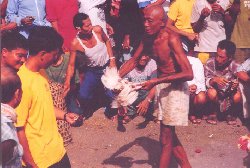 |
A long day for all of us. We were glad
when we finally got back to Ubud at dusk, and moved back into our familiar room at the
Kokokan.
Bali (III)...
dktdavis@aol.com

















